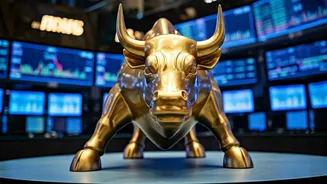Market Players: NSE & BSE
The National Stock Exchange (NSE) and the Bombay Stock Exchange (BSE) are fundamental to the Indian stock market. Information about NSE includes details
regarding the top losers, along with the 52-week highs and lows. Similarly, the BSE is also a crucial element of the market, influencing trading activities. Both the NSE and BSE are constantly influenced by diverse factors, shaping the overall market sentiment and influencing investment decisions. Both indices are important as they determine the flow of buyers and sellers for various stocks. Understanding the interplay between these exchanges is key to grasping the broader market dynamics.
Price & Volume Shocks
Significant price movements, denoted as 'Price Shocker', and fluctuations in trading volumes, known as 'Volume Shocker', are common events in both NSE and BSE. These events could be due to several reasons, including economic news, company announcements, or global market trends. The 'Price Shocker' highlights substantial price changes, either upward or downward, which can significantly influence investor sentiment. Similarly, the 'Volume Shocker' indicates unusually high trading activity, frequently associated with substantial price volatility. These phenomena give traders opportunities to capitalize on market inefficiencies.
Top Gainers & Losers
Tracking top gainers and top losers offers crucial insights into market performance. The NSE Top Losers recorded 1302, and the NSE Top Gainers had a count of 1839. On the BSE, the top losers reached 2390, while the top gainers totaled 3351. These figures indicate which stocks are experiencing the most upward and downward movement in a given period. It helps in recognizing current market trends and potential investment opportunities. Analyzing the drivers behind these movements can help in making informed decisions.
IPO Dynamics
The Initial Public Offerings (IPOs) are significant occurrences in the financial market. The IPOs Open and Upcoming number was 2. This suggests a phase of market activity where new companies are entering the public market, which may provide more investment avenues for traders. IPOs play a role in capital formation and market liquidity, but they are also closely related to risk. Understanding the IPO market and its trends is important. Analyzing the IPOs gives investors opportunities to make informed decisions and strategize accordingly, keeping in mind the volatility.
Market Indices
Several market indices reflect the overall performance of the Indian stock market. These indices, like the Top Indices Performance, provide a snapshot of the health of the market. Watching these index performances helps gauge overall market sentiment, which reflects collective investor behavior. They are also used to measure various market conditions, helping investors to measure their portfolios’ performance. Regularly monitoring these indices provides a critical perspective on the wider investment landscape and helps with sound investment decisions.
Investor Cues
Events like Muhurat Trading sessions are often important for investors. These special sessions can indicate market sentiment and set the tone for future trading. Investors watch out for significant cues, during these events. Monitoring these cues, alongside other market indicators, is essential for a comprehensive market analysis. These cues could be linked with different events. Keeping track of them provides helpful insights for making informed decisions and preparing for future trading sessions.














